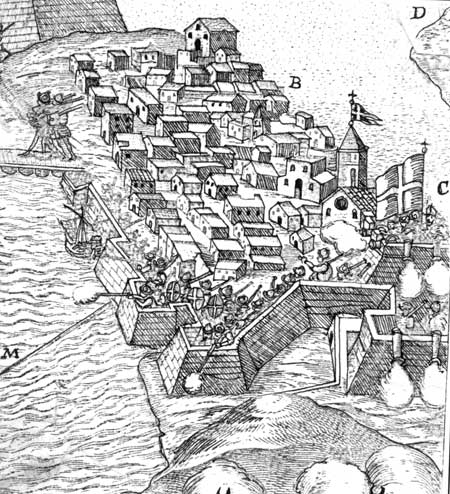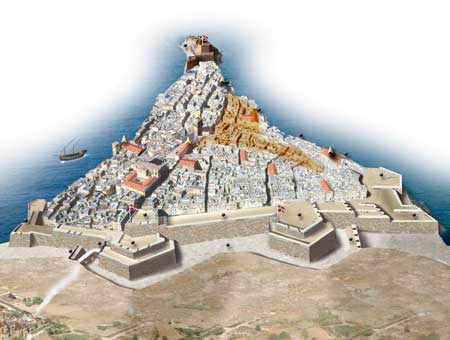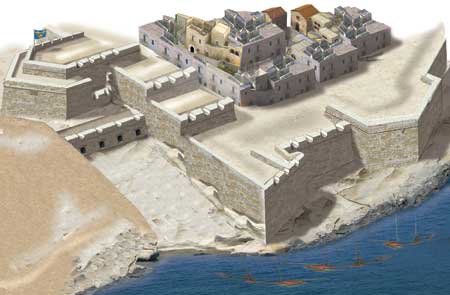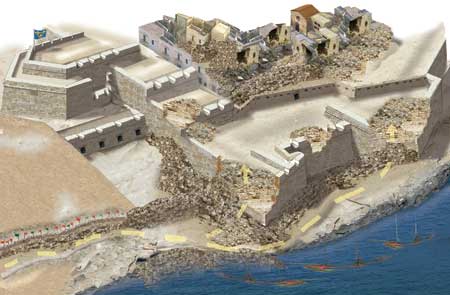 |
|
Citta' Nuova in the 1560s
|
On its arrival to Fort St Angelo in 1530, the Knights of the Order of St John radically disturbed the old political, religious, social, and economic patterns of Borgo. The newly changed rules and styles of the Order’s Government, coupled with its values, ideas and inordinate taste for luxury created new demands, new opportunities, and new expectations. However it also raised new problems which were to give Birgu and its inhabitants an entirely new lifestyle.
With the exception of the Desguanes family who were created barons in the 14th Century, there was no other nobility on the Islands at the time although there were a number of gentry land-owners. As the Knights occupied Borgo, these distinguished citizens steered clear of them and dwelled within Citta Notabile.
The Order immediately raised Borgo to the status of a City, renaming it Citta Nuova, and establishing it as a new municipality – distinct from Citta Notabile (Citta Vecchia). It also took over the Parish Church of St Lawrence for 20
scudi a year and used it as its Conventual Church – compelling the Parish Priest to fulfil his functions from the Church of the Annunciation. The Order also built a small church dedicated to St Anthony the Abbot. This was to serve as a Parish Church for the
Donats, or high-ranking persons, as well as others in the services of the Order. Apart from that, the Knights set up the Church of Our Lady of Damascus, or Santa Maria dei Greci, which was run by a
Papas to serve as a Parish Church for the Greeks who had accompanied the Order to Malta from Rhodes.
 |
|
Artist impression of the development of the land front fortifications by 1565
|
In 1532 the Order bought and demolished several houses on one of Citta Nuova’s most beautiful sites facing Salvatore Hill (Kalkara) so as to make way for the Holy Infirmary – the Order’s hospital. In 1533 it decided to set the Collachio – an area reserved exclusively for the Hospitallers. The main thoroughfare from the Main Gate to the Main Square was used to delineate the boundary and divide the city into two socially distinct areas: the Collachio to the east – as the secluded part of the Convent, and the Fuori Collachio to the west – for the native population. Although there was no dividing wall, a demarcation line was set by a series of square granite bollards – one of which still survives in the main square in memory of that social divide. In actual fact however, the divide never took place and remained a theoretical concept.
In 1538 the Order built its first arsenal near St Lawrence Church so that it could carry out its naval repairs in Birgu rather than in Messina. In 1541, the Order built a quay from St Angelo to the gate leading to Bormla – lining the wharf with heavy rings with which to moor galleys, while in 1545 the Knights started producing sailcloth of cotton fibre for its galleys and other vessels.
When the Order came to Birgu, they found no other protective fortifications than the Castle across the ditch. However by 1535 the Order had already erected some 700 metres of defence lines facing Kalkara. Furthermore, as Giacomo Bosio recorded, the Knights ordered that the new city, – “the suburb of fishermen’s and sailors’ houses that had grown under the shelter of the Castle, be enclosed by a fortified wall”. Its construction began in 1541, thus embarking on a fortification system of its landward side using the Italian bastioned system of defence. By 1560, St Angelo’s ditch had been deepened, and the Post of Castille, with its elegant horn-work, was linked to the Fort by lateral walls.
Birgu’s protection from the landward side was designed by Antonio Ferramolino da Bergamo and consisted of a continuous curtain wall – broken by the St John and St James bastions at the centre, and by two demi-bastions at the water’s edge. The entire line of defence also included a dry ditch – thus separating Birgu from the rest of Malta and creating a double-insulation of St Angelo from the land-front side. The city’s main entrance area demonstrates how carefully the approaches of a medieval city were guarded. The Main Gate is concealed behind a complex network of bastion walls and is ingeniously covered by two advanced posts; namely the Post of Aragon and the Post of France – each of which is separated by ditches. Within the gates, storehouses and horse stalls were provided for the cavalry.
To protect Birgu from the seaward side, the Order brought an iron chain from Venice in 1554. When this was drawn between Fort St Angelo and Isola point, Galley Creek would have been completely blocked off from any invading ship. This chain was replaced in 1564.
This way, in the short span of a mere 30 years or so, the Order had altered the town’s role as a medieval maritime centre meeting the modest needs of seaborne traffic, into that of a fortress – geared to meet all possible aggression.
Needless to say, this sudden and massive construction activity must have given Citta Nuova a substantial economic boost. However the need to find accommodation in Birgu for the Hospitallers, as well as for around 3000 Rhodians that accompanied them, meant that the few houses that could provide some modicum of comfort were all taken up to meet the Order’s requirements. This triggered an acute social housing problem – a situation that was aggravated all the more during the Great Siege when thousands came to seek refuge within the shelter of the town’s fortifications.
In June 1558, soon after La Valette’s induction as Grandmaster (1557-68), the Order decided to move from Borgo to Mount Sciberras. However this decision could not be implemented immediately, and hence the urgency to complete the fortifications of the new city. Feeling the social need to be closer to the people, as well as the urgency to fortify the new city, La Valette decided to move residence into the town. From there, he could better monitor the situation while also supervising the building of the fortifications at which all the men and women of the island were toiling. That is why, in November 1558, Grandmaster La Valette set up residence in a narrow and unpleasant street on the highest and airiest part of the town – at one time a Jewish Quarter or Ghetto. The house, formerly owned by the Conventual Conservator (or Draper) Tessieres, was refurbished to serve as a Magisterial Palace, and enlarged so as to accommodate the eleventh General Chapter of the Order.
By this, La Valette had set the ground to prepare Citta Nuova for the siege that seemed all but inevitable.
|

|

|
|
Post of Auvergne and Post of Castille under siege in 1565 (Alvernja)
|

